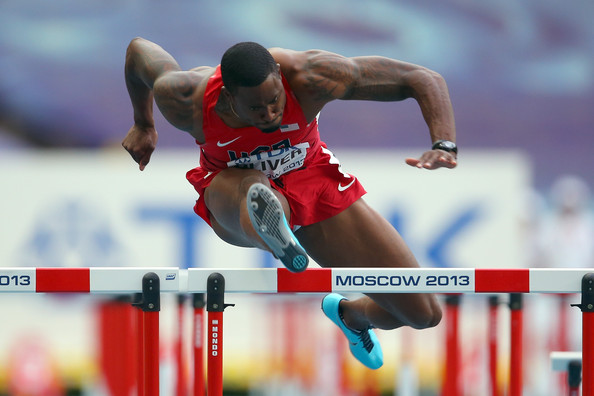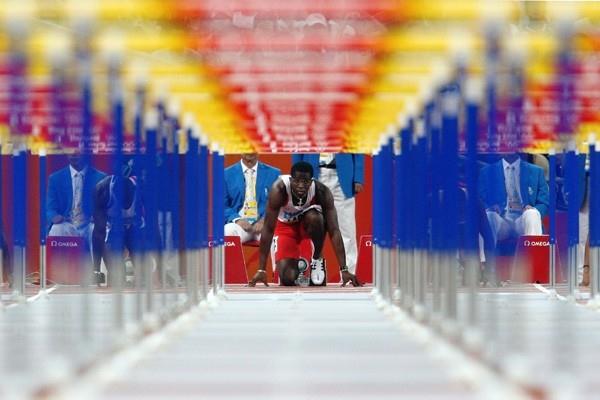Beware of Mimicking the Greats
All of us love watching the best hurdlers compete, and critiquing their races, their hurdling styles, so we can get a better idea of what will work for us. But realistically speaking, very few hurdlers out there have the ability to compete at a Diamond League level, no matter how hard they train nor how much passion they have for the event. But the mindset many have is that if I do what the best do, I can be that good too. But the truth is, the rules that apply to elite level athletes are often not the same rules that apply to athletes of lesser talent levels. So it’s quite possible to develop bad habits in technique, or to overtrain, or too try weight room exercises that one is not properly prepared for, all in the name of trying to emulate a hurdling hero.
[am4show not_have=’g5;’]
[/am4show][am4guest]
[/am4guest][am4show have=’g5;’]
A better idea is to spend more time studying your own hurdling style and that of your competitors, and that of hurdlers who run similar times and/or who have similar body types. More often than not, elite hurdlers can serve as models of excellence, as key reference points, but to take it further than that can be counter-productive.
Let me give three examples – one very specific and two that are more general.
Last year I was coaching a hurdler who was a true student of the event. He was always on YouTube watching races of current and back-in-the-day greats. He had a period when he became hooked on David Oliver. He liked how Oliver tilted his body so that his torso was pushing down on his lead leg. I called it the “shoulder lean” style because both shoulders were leaning to the right.
It was quite evident that Oliver’s shoulder lean contributed significantly to his very efficient hurdle clearance. While other hurdlers may have been quicker in between and may have had more efficient trail legs, nobody got their lead leg back on the ground as swiftly as Oliver.
When my hurdler tried to incorporate the D.O. shoulder lean into his style, he did noticeably snap his lead leg down faster. But it also created problems. The trail leg was wider and lower and was hitting hurdles. He was landing off-balance off hurdles. As a result, he was losing speed between the hurdles despite the snappier lead leg.
The truth is, D.O., throughout most of his career has had the same problems. Except he hasn’t had the issue of losing speed between the hurdles. That’s because he’s 6-3, 200 pounds, with a chiseled, muscular frame. Someone of his body type can get away with riding the lead leg all the way down the track (although the other aspects of his technique have improved in recent years). Kingdom was Oliver’s favorite hurdler growing up, and Kingdom hurdled almost exactly the same way. Riding that lead leg with the shoulder lean.
Which tells you what? That it’s a big man’s style. My hurdler was 5-11, maybe 6-0, about 170 pounds. The Kingdom/Oliver style wasn’t going to work for him.
The two general examples I’d give are the seven-step phenomenon and the Aries Merritt lead arm phenomenon.
When seven-stepping started to take wing back around 2008 due to the success of Dayron Robles, I had no idea it would lead to everybody and their granddaughter giving it a try within six years. There are PLENTY of college and high school hurdlers, male and female, seven-stepping who have no business doing so. People get infatuated with trends, they’re desperate for anything that might give them an edge, so they follow the lead of the greats.
When Aries Merritt was just another guy trying to survive on the circuit, nobody was copying his lead arm style. I remember, in fact, that people were laughing at it. That big sweeping action just looked funny. But after 2012 and 12.80 and an Olympic gold medal you got little kids in youth track doing the Aries lead arm. It’s almost become a fashion statement. People do it just to do it, just because it looks cool. They have no understanding of the nuances regarding timing and power that the style involves.
I have found that, although much can be gained from studying the races of world class hurdlers, the average high school hurdler is better off studying the styles of the hurdlers lining up against him. If I’m Orlando Ortega, I need to study Aries and Oliver and Martinot-Lagarde because they’re the guys I’m battling every weekend. Similarly, if I’m a 16.5 guy racing a 16.1 guy, I need to study that 16.1 guy, and other 16.1 guys, to figure out what they’re doing that I’m not doing.
Even opponents who aren’t beating you may be doing things that you can learn from. So it’s not just a matter of studying your opponents so that you can beat them, but of acquiring as much knowledge as possible so that you can get the most out of your talent.
When I was in college and didn’t have a hurdle coach, I watched my opponents warm up and I watched the other heats of my event. That’s how I picked up on stuff. My teammates and I coached each other, watched each other, and learned from each other.
In my coaching, I like to discuss the styles of the greats with my athletes, but I make it a point to monitor how much they actually try to incorporate. Everyone knows I love me some Liu Xiang, but his style requires exceptional flexibility and explosive power. So I will not advise a hurdler of mine how lacks the necessary flexibility and/or lower to hurdle like Liu, even if that may be the long-term goal.
Ultimately, it is the coach’s job to establish and maintain an open dialogue with his or her hurdlers, helping them to find the balance between learning from the examples set the world’s best without trying to imitate their every move. I like for my athletes to explore on their own, but I also know that without my input, they may head down paths that may, at the very least, stunt their growth.
[/am4show]



